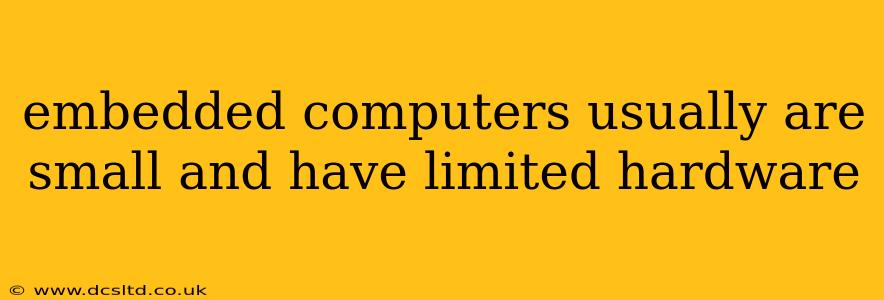Embedded Computers: Powerhouses in Miniature
Embedded computers are everywhere, silently powering the devices we use daily. From smartphones and smartwatches to cars and industrial machinery, these miniature powerhouses play a crucial role in our modern world. But what exactly defines an embedded computer, and what are its limitations? This article will explore the characteristics of embedded computers, focusing on their typically small size and limited hardware resources, and delve into common questions surrounding this technology.
What is an Embedded Computer System?
An embedded computer system is a specialized computer system designed to perform a specific task or set of tasks within a larger system. Unlike general-purpose computers like laptops or desktops, embedded systems are not designed for general use or user interaction. Instead, they operate in the background, often invisibly to the end-user. Their primary function is to control or monitor a specific device or process. This specialization allows for optimization of size, power consumption, and cost.
Why are Embedded Computers Usually Small and Have Limited Hardware?
The small size and limited hardware resources of embedded computers are directly related to their purpose and application. Several factors contribute to these characteristics:
-
Application-Specific Design: Embedded systems are designed for a specific purpose. Unnecessary components are omitted to minimize size, weight, and cost. This focused design prioritizes efficiency and functionality within the constraints of the application.
-
Power Consumption: Many embedded systems operate on battery power, requiring extremely low energy consumption. Limited hardware reduces power demand, extending battery life and reducing heat generation.
-
Cost Optimization: Reducing the number of components significantly lowers the manufacturing cost, making embedded systems economically viable for mass production.
-
Physical Constraints: In many applications, the physical space available is limited. Embedded computers are designed to fit within tight spaces, often integrated directly into the device they control.
H2: What are the key features of an embedded system?
Key features of embedded systems include:
- Real-time operation: Many embedded systems need to respond to events within strict time constraints.
- Dedicated function: They are designed to perform a specific task, unlike general-purpose computers.
- Resource constraints: Limited processing power, memory, and storage are common.
- Interaction with hardware: Direct interaction with sensors, actuators, and other hardware peripherals.
- Reliability and robustness: Designed to operate reliably in harsh environments.
H2: What are some examples of embedded systems?
Embedded systems are ubiquitous. Examples include:
- Smartphones and Tablets: While powerful, their operating systems and many functions are fundamentally embedded systems.
- Automotive Systems: Engine control units (ECUs), anti-lock braking systems (ABS), and airbags all rely on embedded systems.
- Industrial Control Systems: Robotics, process automation, and programmable logic controllers (PLCs) heavily utilize embedded computers.
- Medical Devices: Pacemakers, insulin pumps, and other medical equipment rely on sophisticated embedded systems.
- Consumer Electronics: Televisions, microwaves, washing machines—many everyday appliances have embedded systems for control and monitoring.
H2: What are the limitations of embedded systems?
While incredibly powerful for their purpose, embedded systems do have limitations:
- Limited processing power: Their processing capabilities are typically less than general-purpose computers.
- Memory constraints: Limited RAM and storage can restrict the complexity of software.
- Upgradability challenges: Updating or modifying the software in embedded systems can be difficult.
- Debugging complexities: Troubleshooting issues in embedded systems can be complex and time-consuming.
H2: How do embedded systems differ from general-purpose computers?
The primary difference lies in their purpose and design. General-purpose computers are designed for versatile use, while embedded systems are tailored to specific tasks within a larger system. General-purpose computers have much greater processing power, memory, and storage capacity. Embedded systems prioritize efficiency, low power consumption, and cost-effectiveness over general-purpose capabilities.
H2: What programming languages are commonly used for embedded systems?
Several languages are commonly used for embedded system programming, including C, C++, and assembly language. The choice often depends on factors such as the system’s resources, performance requirements, and the developer’s experience.
Conclusion:
Embedded computers are indispensable components of our modern technological infrastructure. Their small size and limited hardware, often considered limitations, are actually design features crucial to their effectiveness and wide-ranging applications. Understanding their capabilities and constraints is key to appreciating their pervasive influence on our lives.
